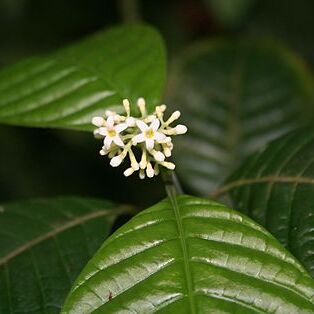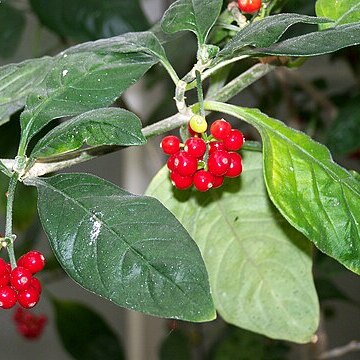Mostly shrubs but less often trees, lianes or subshrubs, some even ± herbaceous. Leaves opposite, petiolate, frequently drying reddish-brown in colour, either with domatia or with bacterial nodules the former mostly in the main nerve-axils but the latter either scattered throughout the lamina or variously restricted, sometimes only a very few at the base of the midrib beneath; less often neither domatia nor bacterial nodules are present; stipules either entire or variously fimbriated, usually deciduous; colleters present. Flowers mostly small, sessile or pedicellate, 4–5-merous, hermaphrodite, heterostylous in terminal or axillary (in some American species) capitate or paniculate inflorescences; bracts and bracteoles small or large, variously placed, sometimes one bract subtending 2 or 3 flowers or only 1 flower or absent; often there is an involucre of bracts (sometimes large) and in some groups (particularly those previously considered to be worth recognising as Cephaelis) united and surrounding the whole inflorescence. Calyx-limb usually a short tube with mostly minute or less often shortly linear or ovate lobes. Corolla-tube mostly shortly cylindric, hairy at the throat save in a few species; lobes always valvate, often thickened at the apex, sometimes with little projections which show as small horns in bud. Stamens with long filaments in short-styled flowers and shorter filaments in long-styled flowers, mostly inserted about the middle of the tube. Ovary 2(rarely –3–4)-locular, each locule containing a single erect ovule; style filiform, long or short with 2 (rarely 3–4) linear stigmas; disc small, surrounding the base of the style. Fruit a drupe, very often red or in bracteate species often blue or black, with 1–2 (rarely 3 or 4) pyrenes. Seeds mostly 1/2-ellipsoid with plane ventral face and convex dorsal face; testa usually reddish brown; endosperm horny, entire, strongly ruminate or with a variously shaped median ventral fissure.
Subshrubs, shrubs or trees, rarely scandent, occasionally epiphytic. Leaves rarely sessile, opposite; stipules free or connate, usually caducous. Inf orescences usually terminal, often paniculate, occasionally aggregated into heads; bracts usually persistent, occasionally involucrate; bracteoles usually present, often de-ciduous. Flowers mostly small, (4-)5(-8)-merous, bisexual, often heterostylous, the hypanthium small, the calycine cup usually short, occasionally with small glands within, the lobes or teeth absent or present, usually 5; corolla usually white or yellow, the tube short, the lobes valvate in the bud, occasionally galeate; stamens included or exserted, the anthers usually narrowly oblong, the filaments variously inserted in the corolla tube; ovarian disc usually cushion shaped, the style solitary, slender, the stigmas 2(4-5), the ovary 2(4-5)-celled, the septum thick, the ovules 1 per locule, attached basally. Fruits fleshy, the flesh usually soon deciduous exposing 2 pyrenes, the endocarp of the pyrene ventrally flat or grooved, dorsally costate or ecostate, the testa thin, the albumen hard, sometimes ruminate.
Flowers mostly small, sessile or pedicellate, 4–5-merous, hermaphrodite, heterostylous, in terminal or axillary (in some American species) capitate or paniculate inflorescences; bracts and bracteoles small or large, variously placed, sometimes one bract subtending 2 or 3 flowers or only 1 flower or absent; often there is an involucre of bracts (sometimes large) and in some groups (particularly those previously considered to be worth recognising as Cephaelis) united and surrounding the whole inflorescence.
Leaves opposite, petiolate, frequently drying reddish-brown in colour, either with domatia or with bacterial nodules, the former mostly in the main nerve-axils but the latter either scattered throughout the lamina or variously restricted, sometimes only a very few at the base of the midrib beneath; less often neither domatia nor bacterial nodules are present; stipules either entire or variously fimbriated, usually deciduous; colleters present.
Corolla tube mostly shortly cylindric, hairy at the throat save in a few species; lobes always valvate, often thickened at the apex, sometimes with little projections which show as small horns in bud.
Seeds mostly semi-ellipsoid with plane ventral face and convex dorsal face; testa usually reddish-brown; endosperm horny, entire, strongly ruminate or with a variously shaped median ventral fissure.
Ovary 2 (rarely 3–4)-locular, each locule containing a single erect ovule; style filiform, long or short with 2 (rarely 3–4) linear stigmas; disk small, surrounding the base of the style.
Stamens with long filaments in short-styled flowers and shorter filaments in long-styled flowers, mostly inserted about the middle of the tube.
Fruit a drupe, very often red or in bracteate species often blue or black, with 1-2( rarely 3 or 4) pyrenes.
Calyx limb usually a short tube with mostly minute or less often shortly linear or ovate lobes.
Mostly shrubs but less often trees, lianes or subshrubs, some even ± herbaceous.


